Exercises (2276)
Squat and jump in the air (squat jump) alternating ► squat tuck jump
Power
Individual work



Stand upright shoulder-width apart with your arms outstretched in front of you at chest height, bend your knees to approximately a right angle at the knee joints (squat position, buttocks approximately at knee height), push your legs off the floor to jump upwards (raise your arms horizontally as a swing). During the jump, pull your knees up towards your chest as far as possible (squat jump). Then land in a controlled manner (cushion the jump; bend your knees), straighten your legs and straighten your upper body to return to the starting position.
Attention:
Keep your back straight, cushion the jump when landing, keep your whole foot on the ground without bending your knees and keep your knees behind your toes while your legs are in contact with the floor. The palms of your hands touch your knees with every jump.
Lighten:
Smaller/less intense jumps, pull your knees up less.
Harder:
Additional weight; jump on a soft surface.
2-4 weight cuffs/shorter weights/1 weight waistcoat ► making the exercise more difficult (additional weight)
1 small/large soft mat ► making the exercise more difficult (base)
Squat and jump to the side alternating ► squat & side jump
Power
Individual work










Get into a squat position with one leg on the balance half sphere, straighten your legs and simultaneously jump to the other side of the half sphere so that you change your standing leg on the sphere. With the landing movement, perform another squat and then jump back to the starting position in a fluid transition. In this way, the trainee jumps continuously from one side of the balance half-ball to the other and changes their standing leg on the training device with each exercise. In the lower squat position, the arms are bent and brought together in front of the body (landing), while the arms hang next to the body (flight phase) when the body is extended.
1 balance hemisphere
Squat and lunge alternating in jump (alternating jump) ► squat & jumping lunge
Power
Individual work
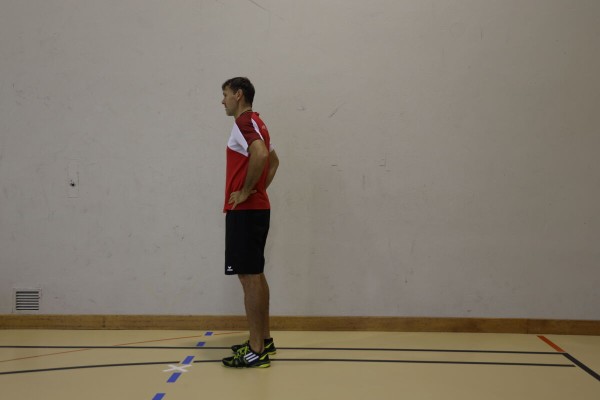
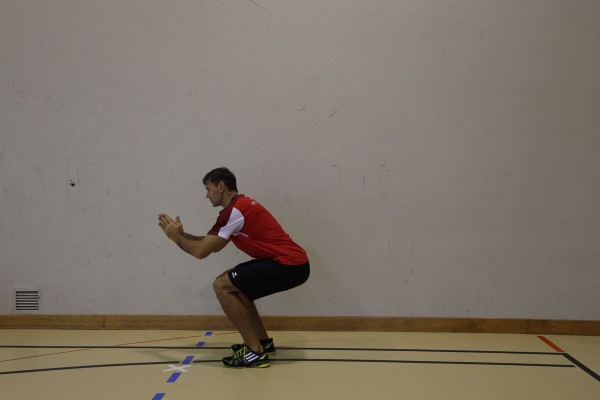
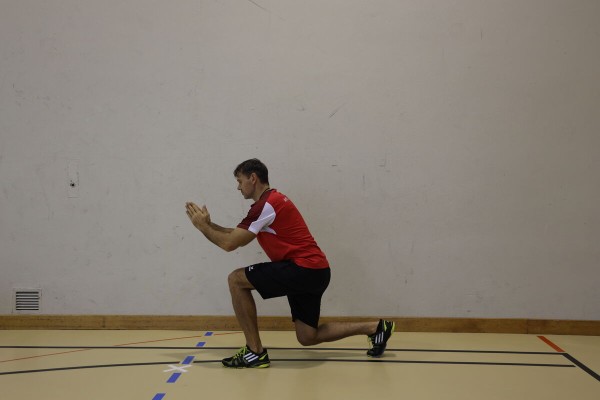

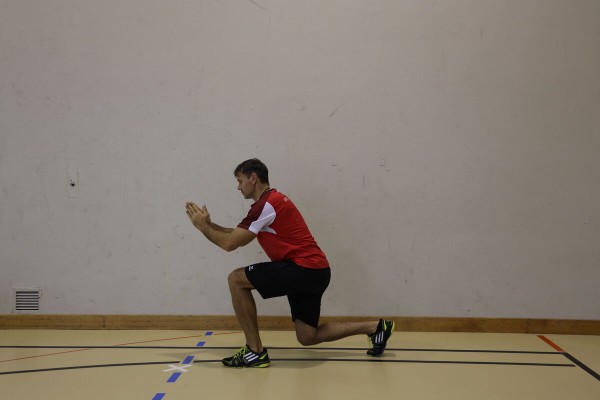
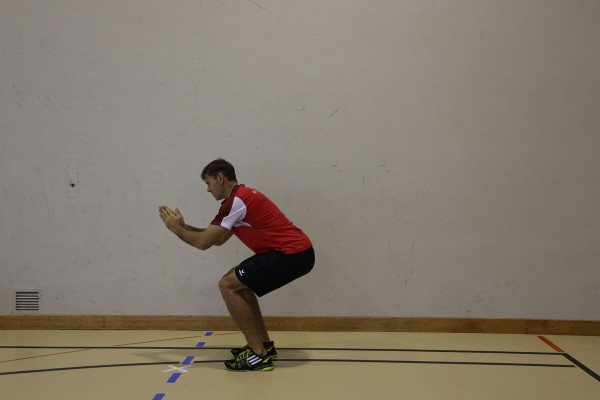







Stand with your feet shoulder-width apart, arms supported on your hips, bent or in front of you at chest height, bend your knees to approximately a right angle at the knee joints (buttocks at about knee height). From the deep squat position, perform a lunge backwards (upper body upright, abdomen tensed), arms again supported on the hips, folded on the chest, bent in front or at an angle, front (and back) leg bent to a right angle, two-legged jump to change leg position during the jump (move back leg forwards and front leg backwards - body position remains low), new alternating jump to return to the starting position in the lunge. Move the back leg forwards to the deep squat position before stretching the legs back to the starting position in a shoulder-width stance. After the new squat, change the side of the lunge compared to the previous version.
Attention:
When squatting, move your buttocks backwards, not your knees forwards. Keep your knees behind your toes. Keep your back straight at all times (tense your core), distribute your weight over your entire foot, push your knees outwards (do not tilt them inwards). When lunging, always keep the front knee behind the toe and centred over the foot. Keep your upper body as stable as possible.
Lighten:
Do not lower your buttocks too low (greater angle in the knees) when squatting. Higher basic position/lower upper body less (greater angle at the knees) when doing lunges.
Harden:
Additional weight (on the shoulders, with hanging arms or in a forward or upright position).
Variation:
Jump height can be varied: high jumps with plenty of time to change leg position or only small jumps with quick leg shifts.
1 weight vest/weight disc/(medicine) ball/sandbag/fighting backpack/2 dumbbells ► Make the exercise more difficult (additional weight)
Squat and straddle jump alternating ► sumo squat jump
Power
Individual work

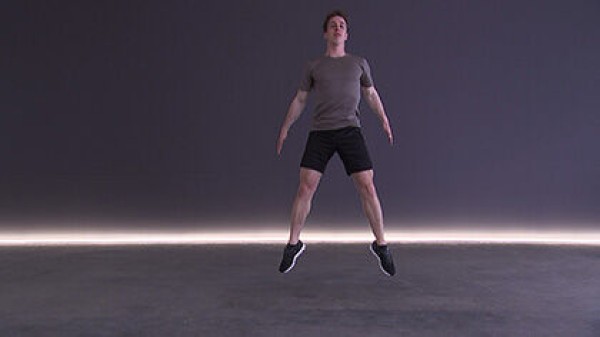
Stand with your feet shoulder-width apart, bend your knees to approximately a right angle at the knee joints (buttocks at about knee height), arms supported on your hips, folded across your chest, bent or in front of you at chest height, jump up and simultaneously spread and stretch your legs (straddle jump), cushion the jump (bend your knees slightly) and return to the starting position.
Attention:
Bring your buttocks back, not your knees forwards. Keep your knees behind your toes. Keep your back straight at all times.
Lighten:
Do not lower your buttocks too low (larger angle in the knees), smaller/less intense/higher jumps.
Harden:
Hold additional weight (on your shoulders, in front of you or with your arms hanging in your hands); larger, more intense/higher jumps.
2-4 weight vest/1 (medicine) ball/weight disc/sandbag/1-2 dumbbells ► Make the exercise more difficult (additional weight)
Knee bend and body extension alternating
Power
Individual work



Stand with your feet shoulder-width apart, arms bent in front of your body (hands at chest height), bend your knees to a right angle at the knee joints (buttocks at knee height, deep squat), stretch one arm overhead at the same time as you stretch your legs (slightly crosswise, hand approximately at the height of the opposite shoulder), squat down again and stretch the other arm upwards with the next body stretch.
Attention:
Move your buttocks backwards, not your knees forwards. Keep your knees behind your toes. Keep your back straight at all times.
Lighten:
Do not lower your body too low (greater angle in the knees).
Harden:
Additional weight (hold on the arms or in the hands).
2 weight cuffs/weight balls/dumbbells/1 weight waistcoat ► Make the exercise more difficult (additional weight)
Squat and jump onto an object alternately ► squat jump
Power
Individual work


Sit on an object lying on the floor (e.g. tyre - both legs inside or one leg inside and one leg outside the tyre), jump off with both legs to stand on the object, jump back to the starting position in the seat.
Attention:
Upright upper body, do not put all your weight down, keep your knees behind the tips of your feet.
Lighten:
Jump straight up from the seat without landing on the object in between (sit with both legs outside the tyre); lower your buttocks less (do not touch the object); lower cadence.
Harden:
Jump up after standing on the object with a direct landing on the seat; additional weight (on the shoulders); higher cadence.
1 tyre (10DM)
1 weight vest/sandbag/fighting rucksack ► to make the exercise more difficult (additional weight)
Squat and jump onto an object alternately ► squat jump
Power
Individual work
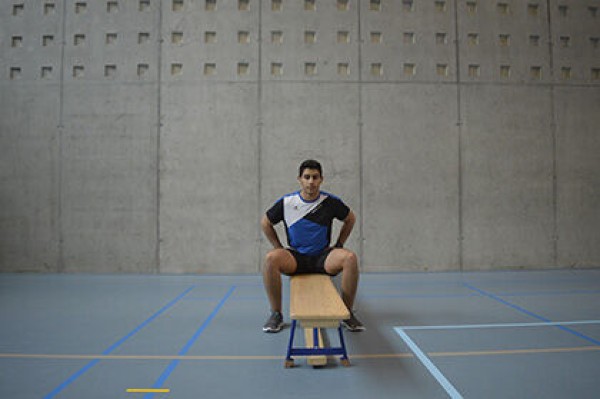

Sit on the long bench (one leg on each side of the bench), arms supported on the hips or in front, jump off with both legs to stand on the long bench, jump back to the starting position in the seat.
Attention:
Upright upper body, do not put all your weight down, keep your knees behind the tips of your feet.
Lighten:
Sit with both legs on the same side of the bench, only jump straight up from the seat without landing on the long bench in between; lower your buttocks less (do not touch the long bench); lower cadence.
Harden:
After standing on the long bench, jump up with a direct landing to the seat; choose a higher element (squat less intense, but jump up more difficult); additional weight (on the shoulders); higher cadence.
1 long bench
2 vaulting box elements (incl. top section) ► Make the exercise more difficult (position)
2 weight cuffs/1 weight vest/sandbag ► Make the exercise more difficult (additional weight)
Squat and stretch jump alternating ► squat jump
Power
Individual work



Stand with your feet shoulder-width apart, bend your knees to approximately a right angle at the knee joints (buttocks approximately at knee height), arms supported on your hips, folded across your chest or in front of you at chest height, jump up slightly, cushion the jump (bend your knees slightly) and return to the starting position.
Attention:
Bring your buttocks back, not your knees forwards. Keep your knees behind your toes. Keep your back straight at all times.
Lighten:
Do not lower your buttocks too low (larger angle in the knees), smaller/less intense/higher jumps.
Harden:
Hold additional weight (on your shoulders, in front of you or with your arms hanging in your hands); larger, more intense/higher jumps.
1 weight vest/(medicine) ball/weight disc/sandbag/1-2 dumbbells ► Make the exercise more difficult (additional weight)
Squat and stretch jump alternating ► squat jump
Power
Individual work
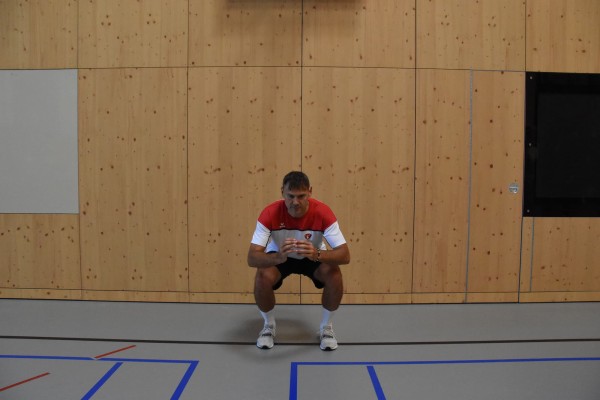
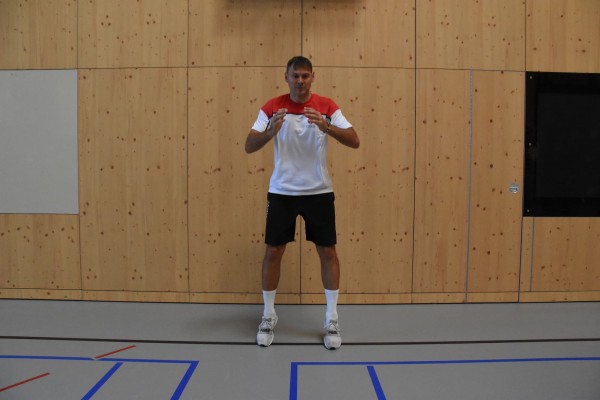

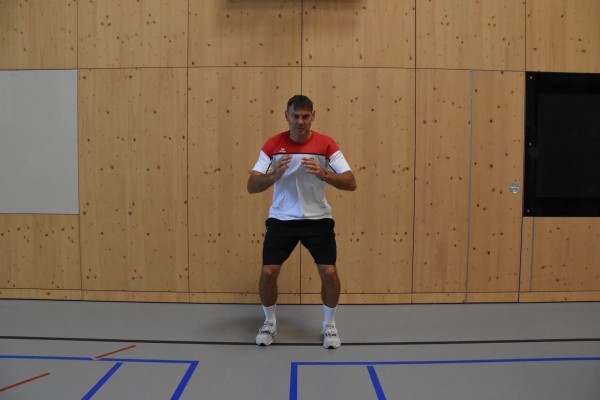
Stand shoulder-width apart, bend your knees almost to a right angle at the knee joints (buttocks slightly above knee height), arms supported on your hips, folded across your chest or in front of you at chest height (possibly with bent arms including hands), jump upwards, cushion the jump and return to the starting position. Repeat the sequence of movements continuously.
Attention:
Bring your buttocks back, not your knees forwards. Keep your knees behind your toes.
Lighten:
Do not lower your buttocks too low (larger angle in the knees), smaller/less intense/higher jumps.
Harden:
Hold additional weight (on your shoulders, in front of you or with your arms hanging in your hands); larger, more intense/higher jumps.
1 weight vest/(medicine) ball/weight disc/sandbag/1-2 dumbbells ► Make the exercise more difficult (additional weight)
Kneecap ► kneedrop
Coordination exercises
Individual work
Position your front foot straight and bend your leg. With your back leg, hook your shin onto the strap and try to push your knee under the slackline.
Lighten the load:
Perform the exercise close to the attachment.
Harden the load:
Touch the slackline with one hand (line grab); stand up again from the kneedrop position, take a step forwards and perform another kneedrop (different forefoot).
1 Slackline
Kneeling position and jumping onto an object ► kneeling position & box jump
Power
Individual work


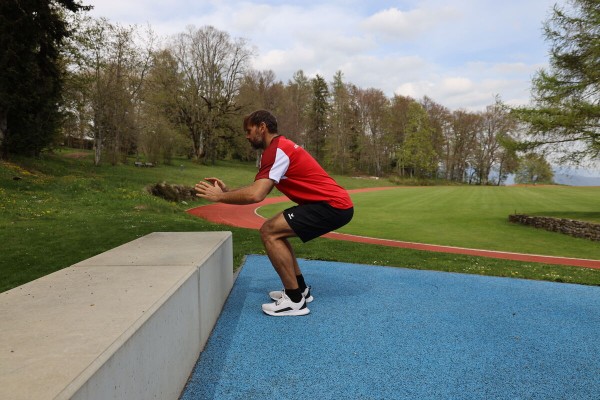

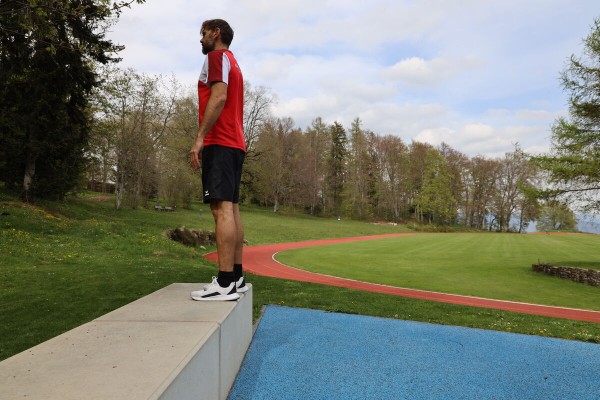
Stand on one knee, alternate between standing on one leg and assuming a deep squat position. From the squat position, tilt your upper body slightly forwards, stretch your arms backwards at an angle to your body (like a ski jumper on a ski jump), push off the floor powerfully to perform a jump onto a raised object (plyo box or swinging box element incl. top) (use the momentum of the arms), straighten your upper body (stand on the object) and jump back to the starting position (possibly the other side of the object), then return to the kneeling position. Change the starting leg with each execution.
Attention:
Land as softly as possible (cushion the jump with your knees).
Lighten:
Lower intensity between each execution; lower the height of the object.
Harden:
Additional weight; higher object.
1 flat bench/plyo box/swivel box
2-4 weight cuffs/1 weight waistcoat ► Make the exercise more difficult (additional weight)
Coconut thieves
Fighting and roughhousing games
Group work
2 teams
The participants in the "pinch team" face each other in pairs and each pinch a medicine ball between their backs/upper body. One after the other, the participants from the "capture team" try to capture the trapped medicine balls. Which team needs less time to conquer the medicine balls?
x medicine balls
1 stopwatch
Conditioning and coordination course (KKP)
Forms of play / exercises
Game idea:
The fitness and coordination course is used to train coordination skills and fitness abilities. The participants move under pressure in a polysportive manner within the specifications. The KKP cannot be moved outside and the posts are precisely prescribed. Securing the elements and considering the risk of injury are the responsibility of the sports director and have the highest priority.
The participants complete the course in 12 minutes and collect as many points as possible in the allotted time. One point is awarded for each obstacle completed (1 lap = 10 points).
Facility:
The course is run outside the volleyball court in an anti-clockwise direction. One colouring stick is placed in each corner of the volleyball court, 0.5m away from the baseline, in the extension of the sideline. The following 10 positions must be prepared:
1. Low jump: 2 long benches suspended from a bar. The inner long bench is 0.5m away from the sideline of the volleyball court. There is a distance of 1m between the benches. The bar height from the floor is 1.20m. The long benches must be secured to the parallel bars with ropes. Behind the parallel bars, 2 small mats are placed next to each other in the direction of travel.
2. Balancing: 2 long benches next to each other with the narrow side facing up. The inner long bench is 0.5m away from the sideline of the volleyball court. There is a distance of 1m between the long benches.
3. Ball catching: Passing a volleyball from a distance of 3m by an assistant (possibly a dispensed person). Reserve balls in a ball trolley / inverted vaulting box top.
4. Dribbling slalom: 7 painting sticks are set up lengthways in the volleyball court to form a slalom. The first stick is 3m from the baseline and 2m from the sideline of the volleyball court. The second marker is placed 5 metres from the baseline and 3 metres from the sideline. The third marker is positioned at a distance of 4m from the first marker and again 2m from the sideline, etc.
5. Football slalom: Analogue dribbling slalom, but in the other direction. The last marker stick is on the baseline.
6. Forward roll: 2 small mats next to each other, parallel to the baseline; the inner mat is 0.5m away from the baseline.
7. Skipping-crawling: 4 vaulting box elements are placed on the floor at a distance of 1.5m each (the opening points forwards/backwards). The first element to be used is the upper part of the box, which is located in the extension of the baseline. 4 small mats between the elements are used as protection.
8. Running backwards: 2 painting sticks next to each other at the height of the centre line, the first is 0.5m from the side line of the volleyball court, the second 1m from the first painting stick.
9. Roll backwards: 2 mats next to each other parallel to the sideline, level with the baseline.
10. Support: A bar in the centre of the front of the volleyball court. The distance to the baseline is 1m. The entry and exit is to be fixed at a height of 70 centimetres using a power hose. The bar height is 1.20 metres.
Execution:
The participants start one after the other at a start interval to be defined (e.g. every 30 seconds). The aim is to complete as many laps as possible within 12 minutes. For example, if a participant starts at 2:30, the course is finished after 14:30. The sports director must therefore always announce the split times.
Depending on the number of participants, the course can be run in one or two groups. In one group, each participant counts their laps independently. In two groups, the course is run in teams of two, with one team member completing the course and the other team member counting the laps completed. After completing the course, the points achieved are recorded on a flipchart or whiteboard.
The following obstacles have to be mastered during the course:
1. Low jump: Balancing over the long benches and low jump over the parallel bars onto the small mats.
2. Balancing: Balancing on the narrow side of the long benches. Anyone who falls off must repeat the element.
3. Ball catching: Catching the ball. A ball that is not caught must be retrieved by the runner.
4. Dribbling slalom: Bounce a ball with the hand around the painting sticks. Knocked over sticks must be set up again by the runner. In the event of a dribbling error, thread the ball back in where the error occurred.
5. Football slalom: Transfer the ball from hand to foot when moving from one side of the slalom course to the other. Guide the ball with the foot in a slalom around the colouring sticks. The runner must put up the sticks again if they are knocked over. In the event of a dribbling error, thread the ball back in where the error occurred. At the end of the slalom course, place the ball back in the container of the pass player.
6. Roll forwards: Perform a roll on the mat.
7. Skip-crawl: The first element is skipped, then alternate between crawling under and skipping.
8. Running backwards: Running backwards begins after bypassing the marker bar.
9. Roll backwards: From the backwards run on the small mats.
10. Support: Anyone who touches the bar floor between entry and exit must repeat the element.
Condition and coordination test (KKT)
Examinations
Time ratios (25 min.) correspond to a group size of approx. 30 participants.
Of course, each participant is tested individually.
The fitness and coordination test (KKT) is used to test fitness and coordination skills. This test checks whether the participant is able to perform polysportive movements within the specifications under load.
Execution regulations
Facility:
The KKT must always be carried out indoors and cannot be moved outside. At the KKT, all posts are precisely prescribed and are located at a clearly defined location. A volleyball court should be marked out in the hall, as the posts are distributed according to certain measurement specifications starting from this
court. The controls are located both inside and outside the volleyball court. Securing the elements to minimise the risk of injury is the responsibility of the test leader and has the highest priority.
Post description:
Low jump: The long bench is attached to the bar rail facing the participant. The wide long bench side points upwards. The (inclined) long bench must be secured to the parallel bars with ropes. The height of the parallel bars from the floor is 1.10 metres. A small soft mat is placed behind the parallel bars to cushion the participant's low jump.
Balancing: The narrow side of the long bench points upwards.
Ball catching: A volleyball is passed from a distance of 3 metres. A participant who was not used in the test acts as the passer.
Slalom 1: Seven painting sticks serve as slalom poles.
Slalom 2: Eight painting sticks serve as slalom poles.
Forward roll: The forward roll is performed on a small soft mat.
Skipping/crawling under: A vaulting box top section and three centre sections are used for jumping over/crawling under. The first element to be used is the top section. The three centre sections are placed between four small soft mats and distributed evenly (fix the mats in place with adhesive tape). The foremost mat lies flush with the top section.
Walking backwards: Walking backwards begins after going round a painting stick.
Rolling backwards: The roll backwards is performed on a small soft mat.
Supporting on the parallel bars: The bar height from the floor is 1.20 metres. When getting in and out, a power hose/rope is fixed at a height of 70 cm. A long bench is required for the "penalty post".
Two lanes are installed at almost all posts so that overtaking is possible. Two long benches are therefore provided for the low jump and balancing (controls 1 and 2), two small soft mats are placed for the forward and backward roll (controls 6 and 9), two colouring sticks are set up for running backwards (control 8) and two Swedish boxes are required for jumping over/crawling under (control 7). There is enough space available for the slalom so that the participants can overtake each other. Two lanes can also be set up for the support (item 10), but there are usually not enough (more than two parallel bars) available in the sports halls.
Execution:
Low jump: The participant runs up the sloping long bench and jumps over the bars of the parallel bars onto the small soft mat placed behind them.
Balancing: The participant balances over the narrow side of the long bench. If the participant falls down, the element must be repeated.
Ball catching: The participant catches the volleyball pass from the passer. A ball that is not caught is retrieved by the participant (no new pass).
Slalom 1: The participant bounces the volleyball around the marker poles. In the event of a dribbling error, the participant threads the ball back into the slalom where the error occurred. The volleyball is placed on the floor between the last marker stick of slalom 1 and the first marker stick of slalom 2.
Slalom 2: The participant guides the volleyball around the marker sticks with their foot. In the event of a dribbling error, the participant threads the slalom back to where the error occurred. Before the last pole (between the 7th and 8th pole), the ball is picked up by hand and placed back in the ball trolley (container) of the passer.
Forward roll: The participant performs a forward roll on the small soft mat.
Skipping/crawling under: The participant crawls under the first and third centre sections of the vaulting box. The second centre section and the top section of the vaulting box are jumped over.
Running backwards: The participant circles around the painting stick once. The participant then runs backwards to the next position.
Roll backwards: The participant performs a roll backwards on the small soft mat.
Support on the parallel bars: The participant supports or swings from one side of the parallel bars to the other. The floor of the parallel bars between the entry and exit must not be touched. If the participant touches the floor between the two power tubes/ropes that define the entry and exit, the element must be repeated. If a participant is unable to support/swing from one side of the bar to the other several times (3 attempts), a "penalty position" must be completed. This involves performing a tricep press on the long bench 4 times - heel stand, legs stretched, upper body supported on the long bench (arms behind the back), hands pointing towards the body, arms bent and stretched (upper body raised and lowered). The triceps exercise can be performed directly on each subsequent round. This alternative is an exceptional variant and is only used if the participant is obviously unable to pass the element (no option/choice of participant - determined by the test leader).
Attempts:
One.
Measurement:
Time: The participant has 12 minutes to collect as many points as possible.
Points: Each completed item scores one point (1 round = 10 points).
Control:
The test leader explains all the execution rules to the participants beforehand and demonstrates the items if necessary (however, all participants should be familiar with the test from training). During the KKT, the test leader remains at the start. The test leader sends the participants onto the course in stages and starts the stopwatch from the first participant. It is important to ensure that there are never more than a maximum of 10 participants on the course. To do this, the test leader can either form groups of max. 10 participants or send the next participant onto the course from the twelfth minute as soon as the first participant has finished the test. The test leader makes a note of the start number and start time for each participant. Start intervals of 10, 20 or 30 seconds make sense. During the KKT, the test leader keeps track of whether the participants are passing through the controls correctly. As soon as the 12 minutes have elapsed for a participant (note the start intervals), the test leader stops them and records where they are, as each completed control adds up to one point. If the start intervals are very short, the participants can wait next to the control point at the end of the KKT without hindering the other participants until all participants have completed the test. The test leader therefore has more time to stop the participants according to the start intervals and can award the points for the last round at the end. The result is recorded directly electronically or transferred later from an evaluation sheet to an electronic device.
Evaluation:
Evaluation forms and electronic evaluation programmes are available for all sports tests:
www.armee.ch/sportausbildung
-> Downloads -> Sports tests -> Evaluation -> KKT
21 stakes, 5 long benches, 2 parallel bars, 10 small soft mats, 2 power hoses/ropes, additional ropes to secure the long benches at control 1, 2 Swedish boxes, 1 measuring tape, 1-2 stopwatches, KKT control sheet including writing materials, possibly a device for electronic data collection.
King's abduction
Fighting and roughhousing games
Group work
2 teams
Two teams each have a castle (a large mat or simply a defined zone). Each team appoints one of their team-mates as king. The king is not known to the opposing team. Each team tries to identify the king of the opposing team and pull him into their own castle. Of course, the other players are allowed to help the king if he is about to be kidnapped. Only pulling, pushing and carrying the opponent is permitted.
2 soft mats (large) ► indoor version
8 marking cones/caps ► indoor and outdoor versions
Royal tournament
Forms of play / exercises
Group work
The playing field is divided into 3-4 zones. First, all participants dribble (bounce the ball, guide it with their foot/toy, juggle it on the stick) with their ball in the lowest/first zone. Whoever captures (plays away) an opponent's ball moves up, whoever loses the ball with or without the opponent's influence (the ball leaves the playing field) moves down (if possible).
Per participant:
1 ball ►basketball, FooBaSKILL, futsal/football, handball, floorball
1 stick ►floorball
8-10 marking cones/caps ►field markings (3-4 zones)
Koordinationstest (KT)
Examinations
Time ratios (60 min.) correspond to a group size of approx. 30 participants.
Of course, each participant is tested individually.
The coordination test corresponds to the Vienna coordination course (with the exception of the figure-of-eight run and scoring table) and is used to test coordination skills. This test checks whether the participants can move within the specifications under time pressure.
Execution regulations
Facility:
The KT must always be carried out indoors and cannot be moved outside. In the KT, all posts are precisely prescribed and are located in a clearly defined place. A volleyball court should be marked out in the hall, as the controls are distributed from this court according to certain measurement specifications. The controls are located within the volleyball court. Securing the bar to minimise the risk of injury is the responsibility of the test leader and has the highest priority.
Post description:
Backward roll-forward roll: A small soft mat is placed in the corner of the volleyball court for the backward roll. For the forward roll, a mat is placed next to the first one.
360° turn: The turn is performed on another small soft mat. The mat is attached to the mat track, which is ready for the rolls.
Balancing: The narrow side of the long bench faces upwards. A line is marked with adhesive tape 0.5 m in front of the end of the narrow side of the long bench.
Figure-eight run: A rope is stretched between two painting sticks (distance 1.5 m) at a height of 0.5 m.
Slalom: Five clubs are used for the slalom. A medicine ball (2 kg, Ø 28 cm) is placed in a tyre.
Cross jump: A rectangle 40 cm wide and 1 m long is stuck to the floor with adhesive tape. Lines on the rectangle at 25 cm intervals serve as orientation (see sketch).
Cross jump: A square (side 0.4 m) is stuck to the floor with adhesive tape, which serves as orientation for the jumps.
Low jump: The bar height from the floor is 1.20 m for the front bars and 1.70 m for the rear bars. The greatest possible distance is set between the bars. Two small soft mats are placed behind the parallel bars to cushion the competitor's low jump (fix the mats with adhesive tape, long side in the direction of movement). There is no small soft mat on the floor of the parallel bars (risk of tripping).
Execution:
Roll backwards-Roll forwards: The roll backwards and forwards is performed on a small soft mat.
360° turn: Jump or step over with a 360° turn around the longitudinal axis of the body (valid from 270 degrees).
Balancing: The participant balances over the narrow side of the long bench up to the mark.
Run of eight: The two painting sticks are run round in the shape of a figure eight. The aim is to run/crawl under the rope on the first loop and jump over it on the second. If the rope is touched, the entire exercise must be repeated.
Slalom: The medicine ball (2 kg, Ø 28 cm) provided in the (gymnastics) tyre is passed through the clubs in a slalom with the hands or feet. The medicine ball is then placed back into the tyre. If a club is tipped over, the participant must stand it up again before the slalom can be continued.
Cross jump: The participant jumps over the centre field 8 times with the outer leg, i.e. crosswise. Finally, a jump is made to the end of the field, landing on both legs. If a mistake is made, the jump combination must be restarted from the beginning.
Square jump: The participant jumps over the square a total of 5 times on one leg. The jumping sequence is: forwards, backwards, right, left (or left, right) and forwards again. In the event of a mistake, the jump combination must be restarted from the beginning.
Lower jump: The participant jumps over/climbs over/climbs the second bar, whereby the first bar must be passed underneath (climbing underneath) in order to reach the floor of the bar between the two bars first. The most common variant for jumping over the bar is for the participant to hold on to one bar with each hand and jump off the floor of the bar, with the arms acting as a support, in order to get onto the lower bar with one leg. The supported leg is then used to push off from the bars, allowing the participant to cross the upper bar with the support of the free-swinging leg. However, there are also other ways to move the body over the upper bar (see overcoming the bar obstacle on the obstacle course in the field).
Target: The landing after the low jump corresponds to the target.
Attempts:
Two, the better attempt is scored.
Measurement:
The running time is measured to the nearest second (round the result mathematically).
The measurement starts with the (start) command of the test leader and ends with the landing after the lower jump (acoustic and/or visual perception).
Control:
The test leader explains all the execution regulations to the participants in advance and shows the controls if necessary (however, all participants should be familiar with the test). During the KT, the test leader accompanies the participant and checks the execution of the exercise. If a mistake is made, the test leader instructs the participant to repeat the entire exercise (except for the slalom, where the participant sets up the club again himself and continues the exercise). If a second test leader is available, the next participant can only be sent onto the course as soon as the participant in front has passed the slalom. There are never more than two competitors on the course. When landing from the low jump, the test leader stops the time. The result is recorded directly electronically or transferred later from an evaluation sheet to an electronic device.
Evaluation:
Evaluation forms and electronic evaluation programmes are available for all sports tests:
www.armee.ch/sportausbildung
-> Downloads -> Sports tests -> Evaluation -> KT
2 stakes, 1 long bench, 1 parallel bar, 5 small soft mats, 1 rope/tape, 1 (gymnastics) tyre, 1 medicine ball (2 kg, Ø 28 cm), 5 clubs, adhesive tape, 1 measuring tape, 1-2 stopwatches, evaluation form including writing materials or device for electronic data collection.
Headstand
Floor and apparatus gymnastics



A triangle is formed on the floor using the head and both hands. The larger the area of the triangle (i.e. the further apart the vertices are), the greater the stability. The body is stretched vertically upwards (bend the legs first, then bring them upwards).
The participants practise the movement form independently using series of pictures or based on the exercise being demonstrated by the instructor. The instructor (or a partner) gives feedback, provides support and checks that the exercise is being performed correctly.
2 soft mats (small) ► indoor version
1 row
outdoor:
turf field
Headstand to support ► tripod to plank kip
Power
Individual work





In a kneeling position, the head and bent arms are supported on the floor; a triangle is formed on the floor with the head and both hands. The larger the area of the triangle (i.e. the further apart the corners are), the greater the stability. This basic position is also the starting position for getting into the headstand. Now lift your knees off the floor and stretch your legs so that they are only resting on the tips of your toes (the position roughly corresponds to the letter "V"). Then lift one leg at a time off the floor and bend it (lower legs/soles of the feet pointing upwards, thighs pointing diagonally downwards); now the body is supported only by the head and hands (maintain balance). From this position, the legs are pushed out together at an angle backwards and upwards, while at the same time the arms are stretched, finally landing in the push-up position (high support, face/gaze downwards).
Attention:
When landing in the high support position (push-up position), consciously tense your torso so that you assume the position immediately (without sagging beforehand).
Lighten:
Lift and bend only one leg off the floor, the other leg remains stretched out on the floor (tiptoe position), making it easier to keep your balance. From this position, push yourself into a high support position.
Harden:
Additional weight (on the feet if necessary)
1 soft mat (small)
2 weight cuffs ► to make the exercise more difficult (additional weight)
Basket collector
Forms of play / exercises
Group work
Exercise description:
The aim is to practise technical/tactical elements intensively, with each participant assuming the position of attacker or defender depending on the game situation. During the exercise, half of the participants are in possession of the ball (= attackers). The remaining players without the ball are defenders. The attackers can shoot at all available baskets, but only once in succession at the same basket. Each defender can get a ball by defending in accordance with the rules (e.g. by stealing the ball or successfully grabbing a rebound). After a successful basket shot, the attacker retains possession of the ball. Each participant counts the baskets scored within a specified time.
Variant:
Vary the ratio of attackers to defenders.
Per 2 participants:
1 basketball/FooBaSKILL ball
Court:
4-6 basketball hoops
Body hit (one touch)
Light-Contact
Partner work
Regular partner exchange.


Two participants stand opposite each other and try to touch each other with their flat hands. The target area is the shoulder (safety note: only hit from the outside, not crosswise) and the knees (possibly also the stomach). Play for time or a certain number of points (possibly integrate partner changes).
Variant:
As a league game/royal tournament (winner advances, loser relegated).
No material required
Body hit (one touch)
Fighting and roughhousing games
Partner work

Two participants stand opposite each other and try to touch each other with their flat hands. The target area is the shoulder (safety note: only hit from the outside, not crosswise) and the knees (possibly also the stomach). Play for time or a certain number of points (possibly integrate partner change).
No material required
Crab fight
Fighting and roughhousing games
Partner work

Two participants lie face to face on their stomachs and lift their arms and upper body off the floor. Now both try to grab their opponent's hands and push them to the floor. The winner is the one who can keep their opponent's hands on the floor for two seconds.
2 soft mats (small) ►indoor version
2 tent sheets ►outdoor version
Indoor post set-up:
Connect the soft mats to each other on the narrow side using Velcro (exercise can also be carried out without mats)
Strength: Raising the upper body in prone position
Light-Contact
Partner work
The participants lie in a prone position facing each other (head facing their partner). At the same time, they raise their upper body and hand each other a medicine ball. The upper body is lowered and the participant with the ball brings it to their forehead and then stretches their arms forwards again. The partners perform the exercise again (raising the upper body), with the other participant now bringing the ball to their forehead.
2 soft mats (small)
1 medicine ball
Strength: Ball kicking in boxing position
Light-Contact
Individual work
From the boxing position, the medicine ball is pushed against the wall and caught again at head height.
1 wall
1 medicine ball